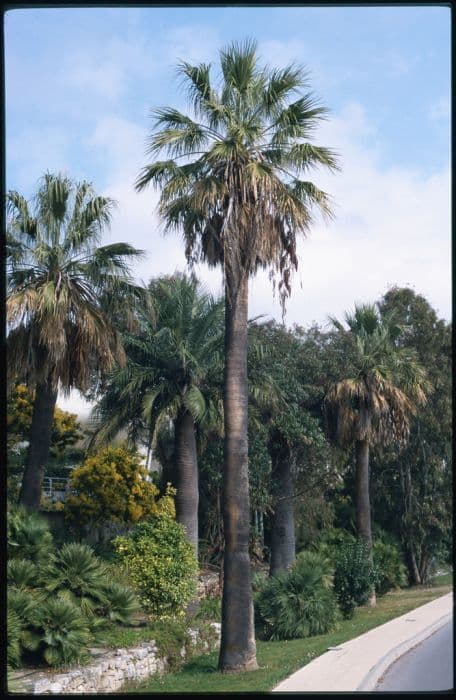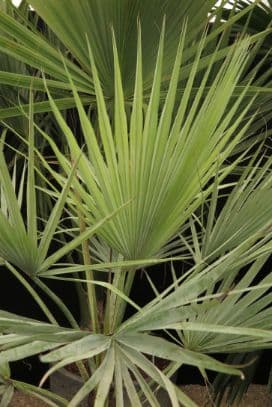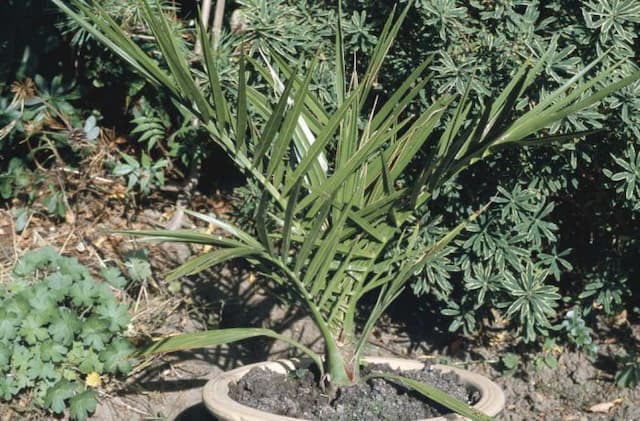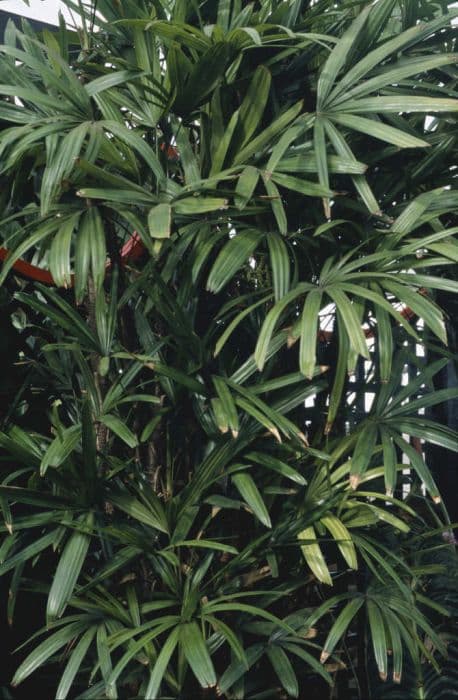Chinese Windmill Palm Trachycarpus fortunei

ABOUT
The Chinese Windmill Palm is a distinctive plant known for its striking features that make it suitable for both ornamental and landscape use. This palm displays a robust trunk that is typically covered in a crisscross pattern of fibrous material, giving it a somewhat shaggy appearance. The trunk's unique texture is often highlighted as it stands as the sturdy support for the crown of foliage above. Atop the trunk sits a dense umbrella of fan-shaped leaves. Each leaf is segmented, radiating out like spokes on a wheel, with a lush green color that adds to the plant's overall tropical charm. These leaves are long, with their tips drooping slightly, creating an elegant canopy. During its flowering period, the Chinese Windmill Palm produces flower clusters that may be less noticeable compared to its lush foliage. These flowers eventually give way to small, blue fruits that can add interest when present, although they are not the focal point of the plant. Overall, the appearance of the Chinese Windmill Palm is one of robustness and gracefulness, with a textured trunk and symmetrical canopy of fan-like leaves which together evoke the essence of tropical and subtropical regions despite its ability to withstand cooler temperatures.
About this plant
 Names
NamesFamily
Arecaceae
Synonyms
Chinese Windmill Palm, Chusan Palm, Windmill Palm, Hemp Palm
Common names
Chamaerops excelsa, Chamaerops fortunei, Trachycarpus caespitosus, Trachycarpus wagnerianus.
 Toxicity
ToxicityTo humans
The Chinese windmill palm is generally considered non-toxic to humans. There are no significant symptoms associated with poisoning because it is not known to be poisonous upon ingestion of any parts of the plant. Therefore, there should be no toxic consequences from ingesting the Chinese windmill palm.
To pets
The Chinese windmill palm is also typically non-toxic to pets. It does not contain any known toxins that would cause symptoms of poisoning in animals such as dogs or cats. Ingesting parts of the Chinese windmill palm should not result in any adverse health consequences for pets.
 Characteristics
CharacteristicsLife cycle
Perennials
Foliage type
Evergreen
Color of leaves
Green
Flower color
Yellow
Height
20 feet (6 meters)
Spread
6-10 feet (2-3 meters)
Plant type
Palm
Hardiness zones
7-11
Native area
China
Benefits
 General Benefits
General Benefits- Ornamental Value: Trachycarpus fortunei, commonly known as the Chinese windmill palm, adds an exotic, tropical aesthetic to landscapes with its fan-shaped leaves and shaggy trunk.
- Cold Hardiness: It is one of the hardiest palm trees, able to withstand cooler temperatures, making it suitable for temperate climates.
- Drought Tolerance: Once established, it has good drought resistance, requiring minimal watering and care.
- Urban Tolerance: This palm can thrive in urban conditions, tolerating pollution and confined soil spaces.
- Erosion Control: The root system can help stabilize soil on slopes, thus aiding in erosion control.
- Wildlife Habitat: It provides shelter and food for wildlife such as birds and insects, particularly during the flowering period.
- Low Maintenance: The Chinese windmill palm requires relatively low maintenance compared to other trees, needing only occasional pruning to remove dead fronds.
- Shade Providing: Mature trees can provide shade for smaller plants, outdoor living spaces, or homes, helping to cool the surroundings.
- Privacy Screen: When planted in groups or rows, these palms can create a dense visual screen for privacy.
 Medical Properties
Medical Properties- This plant is not used for medical purposes.
 Air-purifying Qualities
Air-purifying QualitiesThis plant is not specifically known for air purifying qualities.
 Other Uses
Other Uses- Trachycarpus fortunei's fibers from its leaf sheaths can be used to craft durable ropes and mats. The fibers are strong and able to withstand rough outdoor conditions.
- The palm's young leaves may be woven into hats and baskets. This traditional craft utilizes the flexibility and strength of the foliage before it hardens.
- Its sturdy and attractive trunk, once cleaned and treated, serves as a decorative element in landscaping and garden design, often used to create a tropical look.
- The seeds of Trachycarpus fortunei, known as windmill palm, can be processed to feed birds, as they offer a source of fats and proteins.
- The palm can be cultivated as a natural windbreak or privacy screen due to its dense foliage and relatively fast-growing habit.
- Windmill palm trunks may be hollowed out and used as natural water pipes or for other crafting purposes where tube-like structures are needed.
- Leaflets of the windmill palm can be plaited together to create traditional sandals or slippers in regions where the plant is commonplace.
- The windmill palm's non-invasive root system allows it to be planted near buildings or walkways without fear of structural damage, making it an urban-friendly choice.
- Dried trunk fibers can be used as a natural scouring pad for cleaning pots or other rough surfaces due to their abrasiveness.
- A brown dye can be extracted from the leaves of the windmill palm for use in textile coloring, offering a natural and eco-friendly dyeing option.
Interesting Facts
 Feng Shui
Feng ShuiThe Windmill Palm is not used in Feng Shui practice.
 Zodiac Sign Compitability
Zodiac Sign CompitabilityThe Windmill Palm is not used in astrology practice.
 Plant Symbolism
Plant Symbolism- Resilience: Trachycarpus fortunei, commonly known as the Chinese Windmill Palm, often symbolizes resilience due to its ability to withstand cold temperatures and harsh conditions that are uncommon for most palm trees.
- Endurance: This plant represents endurance because it's capable of surviving in a variety of soils and conditions, showcasing its adaptability and strength over time.
- Longevity: The Chinese Windmill Palm can live for many decades, making it a symbol of longevity and the endurance of life.
- Fortune: Given its species name 'fortunei', this palm is sometimes associated with good luck and prosperity, possibly stemming from its lush and exotic appearance that suggests abundance.
 Water
WaterThe Chinese Windmill Palm, or Trachycarpus fortunei, prefers consistent moisture but doesn't like to be waterlogged. It should be watered deeply until the water drains through, then allowed to dry out somewhat between waterings. In the growing season, water your palm weekly with 1-2 gallons depending on the size of the palm and the weather conditions, reducing the frequency during cooler months. Overwatering can lead to root rot, so it's important to ensure good drainage. In hot and dry weather, you may need to water twice weekly, adjusting as necessary when rainfall contributes to the soil's moisture.
 Light
LightThe Chinese Windmill Palm thrives in a variety of lighting conditions, from full sun to partial shade. Ideally, place the plant in a spot where it receives at least four hours of direct sunlight daily. However, it can tolerate some shade, which is beneficial in very hot climates to prevent leaf scorch.
 Temperature
TemperatureThe Chinese Windmill Palm is hardy and can withstand temperatures down to about 10 degrees Fahrenheit but grows optimally at temperatures between 50 and 80 degrees Fahrenheit. It can survive brief periods of colder weather if properly established, but it's ideal to keep it in conditions that do not drop below the freezing point for prolonged periods.
 Pruning
PruningPruning the Chinese Windmill Palm is generally done to remove dead or damaged fronds and to maintain its appearance. Prune sparingly, ideally in spring or early summer, which is the best time for any necessary trimming. Annually inspecting the palm and removing only the fronds that are completely brown will promote good health and growth.
 Cleaning
CleaningAs needed
 Soil
SoilThe Windmill Palm prefers well-draining soil with a slightly acidic to neutral pH between 6.0 and 7.5. A good soil mix for this palm can be made by combining two parts loam, one part peat moss, and one part sand or perlite. This mix ensures proper aeration and moisture retention, promoting healthy root development.
 Repotting
RepottingWindmill Palms should be repotted every couple of years or when the roots outgrow the pot. They do not like to be pot-bound, so upgrading the pot size is essential to accommodate the growing root system. However, repotting frequency may decrease as the palm matures and growth slows down.
 Humidity & Misting
Humidity & MistingWindmill Palms are tolerant of a wide range of humidity levels but prefer average to high humidity. To thrive indoors, maintain humidity levels above 40%, but they can adapt to lower humidity levels if necessary. Mist the leaves regularly to increase humidity if the indoor environment is particularly dry.
 Suitable locations
Suitable locationsIndoor
Place Windmill Palm in a well-lit spot with indirect light and water regularly.
Outdoor
Plant in a sunny to partly shady area, shelter from strong winds, and mulch.
Hardiness zone
7-11 USDA
 Life cycle
Life cycleTrachycarpus fortunei, commonly known as the Chinese windmill palm, begins its life as a seed, which germinates in warm, moist soil to produce a single sprout with juvenile leaves. As the seedling establishes its roots and grows, it enters a vegetative stage, where it slowly forms a stout trunk and leaves that fan out to capture sunlight. Over several years, the palm matures and once it reaches sexual maturity, it develops inflorescences, which are clusters of flowers that can be either male or female, as the species is dioecious. Following pollination, typically by wind or insects, female palms produce fruit that contains seeds, completing the reproductive cycle. The seeds are then dispersed by gravity or animals, allowing for new plants to begin the cycle anew. The Chinese windmill palm can survive for many years, reaching heights of up to 12-20 meters (40-66 feet), with a slow to moderate growth rate.
 Propogation
PropogationPropogation time
Spring-Early Summer
The Chinese windmill palm, also known as Trachycarpus fortunei, is commonly propagated by seed. The most popular method of propagation for this species involves collecting the seeds, which are usually ripe by late fall, and sowing them in the spring. Before sowing, the seeds should be soaked in water for around 24 to 48 hours to help break down the tough outer shell and encourage germination. The soaked seeds are then sown in a well-draining seed starting mix, typically at a depth of 1 to 1.5 inches (2.5 to 3.8 centimeters). Seedlings can take anywhere from a few weeks to several months to germinate, and it's important to keep the soil consistently moist but not waterlogged during this time. Once germinated, the seedlings can be slowly acclimatized to outdoor conditions and eventually transplanted to their permanent locations.









